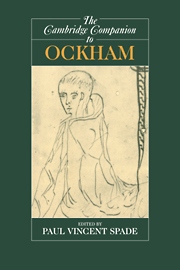Book contents
- Frontmatter
- Introduction
- 1 The Academic and Intellectual Worlds of Ockham
- 2 Some Aspects of Ockham's Logic
- 3 Semantics and Mental Language
- 4 Is There Synonymy in Ockham's Mental Language?
- 5 Ockhams' Nominalist Metaphysics
- 6 Ockham's Semantics and Ontology of the Categories
- 7 Ockham's Philosophy of Nature
- 8 The Mechanisms of Cognition
- 9 Ockham's Misunderstood Theory of Intuitive and Abstractive Cognition
- 10 Ockham's Ethical Theory
- 11 Ockham on Will, Nature, and Morality
- 12 Natural Law and Moral Omnipotence
- 13 The Political Writings
- 14 Ockham on Faith and Reason
- 15 Ockham's Repudiation of Pelagianism
- Bibliography
- Citations
- Index
9 - Ockham's Misunderstood Theory of Intuitive and Abstractive Cognition
Published online by Cambridge University Press: 28 May 2006
- Frontmatter
- Introduction
- 1 The Academic and Intellectual Worlds of Ockham
- 2 Some Aspects of Ockham's Logic
- 3 Semantics and Mental Language
- 4 Is There Synonymy in Ockham's Mental Language?
- 5 Ockhams' Nominalist Metaphysics
- 6 Ockham's Semantics and Ontology of the Categories
- 7 Ockham's Philosophy of Nature
- 8 The Mechanisms of Cognition
- 9 Ockham's Misunderstood Theory of Intuitive and Abstractive Cognition
- 10 Ockham's Ethical Theory
- 11 Ockham on Will, Nature, and Morality
- 12 Natural Law and Moral Omnipotence
- 13 The Political Writings
- 14 Ockham on Faith and Reason
- 15 Ockham's Repudiation of Pelagianism
- Bibliography
- Citations
- Index
Summary
In 1943, Philotheus Boehner, the distinguished Ockham scholar, published an article entitled “The Notitia Intuitiva of Non-existents according to William Ockham,” an article that has been extremely influential ever since.
This date can be regarded as a turning point in the history of the misunderstanding, in whole or in part, of Ockham’s theory of intuitive and abstractive cognition in this century. Before that date, eminent scholars2 had ascribed to Ockham the very doctrine of intuitive cognition of nonexistents he had rejected. In his article, Boehner proceeded to denounce their mistake. Ironically, however, in the very same article, he introduced a new mistake, now bearing on the whole of the theory. Unaware that he had misread a certain text, he ascribed to Ockham a theory of intuitive and abstractive cognition that neither he, nor anyone else as far as I know, ever subscribed to. Though this mistake was introduced in the literature more than fifty years ago, not only has it gone undetected, it has been repeated by most subsequent scholars who have written on the subject, all of whom have studied Boehner’s article. As a result, the mistake has become completely entrenched, and many scholarly discussionson Ockham’s epistemology have been based on the assumption that Ockham held a certain doctrine which, in fact, he never subscribed to, nor even conceived of.
- Type
- Chapter
- Information
- The Cambridge Companion to Ockham , pp. 204 - 226Publisher: Cambridge University PressPrint publication year: 1999
- 10
- Cited by



